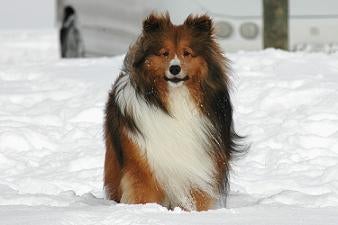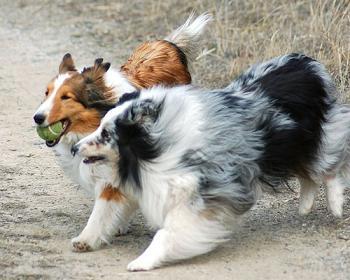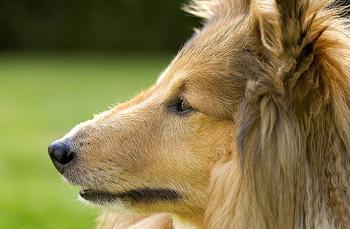Shetland Sheepdog Information & Training
The Shetland Sheepdog or Sheltie as they are widely known make wonderful family companion dogs. Shelties are an attractive and unique blend of intelligence and cheeky playfulness. They show great affection towards their human family and hate to be left out of any family activities!
Shetland Sheepdogs have a beautiful striking appearance and great athleticism to match. Once you've had a Sheltie in your life it is unlikely that you will ever want to own a different breed.
Go straight down to Shetland Sheepdog Training Information.

History Of The Shetland Sheepdog
The Sheltie was developed on the Shetland Islands which are situated just north of Scotland. In the early days they were utilized for their sheep herding ability.Shetland Sheepdogs were first recognized by the Kennel Club in the UK in 1909 and then shortly followed by the American Kennel Club.
Today the Sheltie is one of the most popular of all pure breed dogs - and for good reason.
Shetland Sheepdog Size & Appearance
Shetland Sheepdogs are a very appealing little package - they are often referred to as a "mini Lassie". Shelties are well balanced, smooth moving athletes who possess a nice mix of speed and strength.The obvious and standout feature of a Sheltie is their long luxurious coat and big lion like mane. They are a double-coated breed, with a dense undercoat and long topcoat. In order to keep the coat looking its best and in peak condition it is necessary to give your Sheltie a good brush every couple of days. Doing so will also help to reduce or at least control the shedding.
Shelties have a handsome long wedge shaped head which tapers from the ears to the nose. They have a lovely expressive face, with piercing dark almond shaped eyes and small ears which stand erect but fold forward at the top.
The size of a Shetland Sheepdog varies greatly these days but it is generally accepted that they should stand at between 13 to 16 inches tall at the shoulder. These are guidelines for show Shelties rather than your family companion dog.
Shelties come in three main colors - black, blue merle and sable which can be marked with white and/or tan.

Shetland Sheepdog Temperament & Characteristics
It is the temperament of the Shetland Sheepdog that has made them so highly treasured throughout the dog loving world. Above all else it must be said that Shelties are very much a breed who thrive on the interaction and bond they enjoy with their human family members.Your Shetland Sheepdog breeder plays a crucial role in determining the temperament and behavior habits of your Sheltie puppy. A responsible and reputable Sheltie breeder cares deeply for the breed. They only breed carefully planned litters from healthy, tested, quality breeding stock. Your Sheltie breeder also has the important task of beginning your puppy's socialization period.
Some general characteristics of the Shetland Sheepdog:
- Poor breeding practices have unfortunately led to an increase in Shelties that are highly strung, hyperactive and often nervous specimens. This is yet another reason to always source your Sheltie from a well respected Sheltie breeder (if you are looking for an older dog then a Sheltie rescue center is a great place to go).
- Shelties can become destructive little beasts if left alone and full of energy for long periods. They suffer from separation anxiety in such cases which manifests itself through excessive barking, digging and chewing. Shetland Sheepdogs are happiest when safely inside spending time with their human family.
- Shelties make excellent watchdogs. They are ever alert, have a natural suspicion of strangers and their bark could wake the dead!
- With adequate puppy socialization Shelties are good with children (always under supervision) and other animals. Your Sheltie breeder will start the puppy socialization process and you should continue on with it as soon as your puppy arrives at his/her new home.
- It is clear that many Shelties still retain their herding instincts. They love to play games that stimulate these natural drives such as fetch and any chasing games.
Shetland Sheepdog Health Care
Shelties are a hardy and health dog breed. With some care from you and a bit of luck you will have your happy, active and healthy Sheltie for 12 years or more.The best step you can take in order to secure a healthy and sound puppy is to source your Sheltie from a respected Shetland Sheepdog breeder. They will screen for all relevant genetic health problems and conduct the necessary tests where appropriate.
- Eye disease is one of the most common and harmful health problems encountered by Shelties. Shetland Sheepdogs are prone to Progressive Retinal Atrophy (PRA), Collie Eye Anomaly and also Corneal Dystrophy. Ask your breeder for further information regarding these conditions.
- It's vital that you get your Sheltie onto a well balanced and nutritious dog food diet from an early age. A good diet coupled with some regular exercise will help your Sheltie to avoid becoming obese. An obese Sheltie is an unhealthy Sheltie who is vulnerable to a wide range of serious health problems.
- Other potential Sheltie health problems you should at least be aware of are - von Willebrand's disease, thyroid disease, epilepsy, various cancers, liver problems, kidney complaints and many skin diseases.
- In 99% of cases it is highly recommended that you spay or neuter your Sheltie puppy. There are many benefits in doing so. Note: We don't need to see any more beautiful dogs ending up in the Sheltie Rescue centers which are popping up all over the place.
- A couple of other conditions to be aware of are canine hip dysplasia and displacement of the patella. Once again, ask your breeder for further information.

Shetland Sheepdog Training Information
Shelties love obedience training sessions as well as all other "dog sports". They are enthusiastic and intelligent students who respond brilliantly to non violent, reward based training methods. Shelties can be on the sensitive side at times so there is absolutely no place (or no need) for harsh "old school" training techniques which rely on force, corrections and punishment.Obedience training is the ideal outlet for your Sheltie's abundant energy and vast intelligence. Plus it is time you will spend together which is a bonus for all concerned.
Shelties are one of the very best breeds to work with in the training arena - here's a few points that are particularly relevant to this great breed:
- All of the basic obedience training commands such as sit, down, stay and walking on a loose leash are easily grasped by Shelties. Remember to keep your training sessions short and use plenty of encouragement, repetition and treats to get the job done.
- Shelties are a herding breed who tend to be easily distracted or sidetracked when off lead. For this reason it is essential that you teach and reinforce a good strong come or recall. The come command may save your Sheltie's life one day.
- You'll find that house training your Sheltie will be an urgent priority when your puppy first arrives home. The good news is that Shetland Sheepdogs are a relatively straight forward breed to potty train. You simply need to pick out a good Sheltie housetraining schedule and stick to it to achieve the desired result.
- A very important skill for you and your Sheltie to master is how to behave when on leash. Hopefully you and your Sheltie will spend a great deal of time out and about on walks so it makes sense to teach your dog how to walk nicely on a loose leash.
- Shelties are experts at jumping - they do it often and they do it well. By jumping I mean jumping up on yourself and visitors to your home, and also jumping fences. Once again obedience training your Sheltie is the key to stopping or redirecting this jumping behavior.
- Probably the most evident and annoying trait of the Shetland Sheepdog is their excessive barking. It's important to control this behavior as early as possible so that a bad habit isn't formed and ingrained. Some Sheltie owners have some success controlling the barking by putting the behavior (barking) on cue. Read more about this within this article - Stop Excessive Barking.
Obedience training offers many benefits including the safety of your Sheltie but the biggest benefit I've found is the close bond you and your dog will build and strengthen throughout the training process.
Shetland Sheepdogs are a wonderful breed, if you are considering buying a Sheltie puppy my advice would be to do plenty of research and go for it!
Please consult the services of a Professional Dog Trainer, Behaviorist or Veterinarian before implementing any of the advice contained on this site.











 Your Privacy Choices
Your Privacy Choices